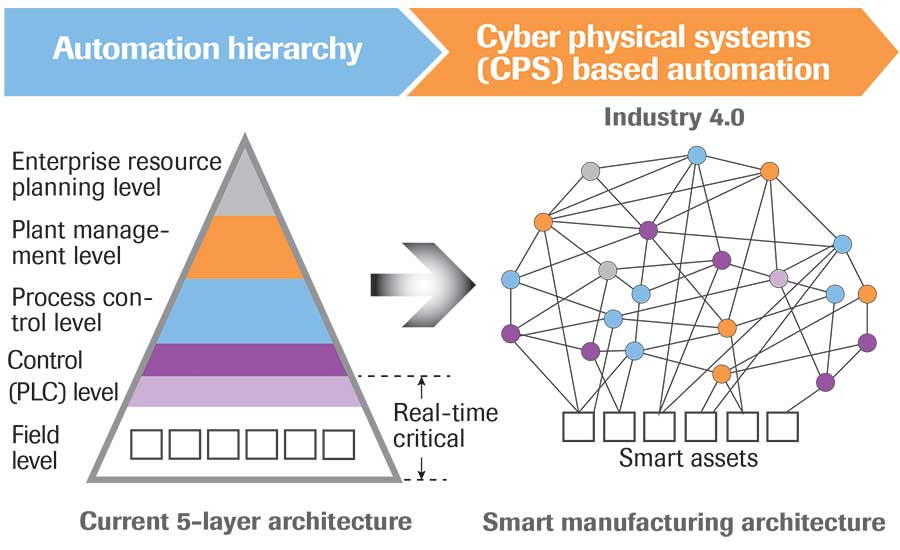A typical plant’s network, a five-layer hierarchy from sensors to the enterprise resource planning level, is evolving toward a new “Industry 4.0” architecture where everything is completely interconnected.
In a recent Control System Integrators Association (CSIA)-hosted webinar entitled “Help your clients migrate to Industry 4.0,” Samy Achour, CEO of Integration Objects (a CSIA partner member) described the smart manufacturing architecture and its ability to allow collected data to be used simultaneously for process data and sensor device integrity, as well as asset “health checks,” for example, vibration sensors on motors or gearboxes.
New in the smart manufacturing architecture is that sensor data is stored in a repository, and it can be used as needed from any software application. Industry 4.0 generally allows for all data accumulated in the plant to be stored in the “cloud” and used as necessary, for example, to perform predictive maintenance calculations for assets, monitor product quality through SPC or quality applications, check and verify batching operations, or even monitor CIP and other variables to satisfy regulatory requirements.
Since all levels of software applications would have access to the data, it’s assumed that ERP systems could play a bigger role than in the past, managing many operational needs that disparate software applications used to handle. While many ERP systems have modules for asset management, LIMS, batching, etc., many processors instead have elected to use separate applications for these functions and leave the ERP to business functions. Whether an ERP system can handle the lower-level functions, such as LIMS, MES, batching, etc., also requires a certain level of integration to make it work.
According to a recent IFS World study entitled, “Industrial Internet of Things (IIoT) and Digital Transformation,” 84 percent of industrial companies polled face a gap between IIoT and ERP, largely due to a lack of integration. According to a survey of 200 IIoT decision-makers at industrial companies in North America, only 16 percent of respondents consume IIoT data in ERP software. That means 84 percent face a disconnect between data from connected devices and strategic decision-making operations, limiting the digital transformation of IIoT. IFS develops and delivers enterprise software for manufacturers around the world.
Today, three factors make IIoT more practical:
- The cost of adding sensors is dropping.
- Cloud computing can handle big data.
- Enterprise software is evolving to make use of this data from networked devices.
Often, the data from connected devices is consumed directly on the plant floor. As enterprise software evolves the data recorded becomes much more valuable to manufacturers.
In the study, respondents were divided into groups including IIoT leaders and IIoT laggards, depending on how well their enterprise software prepared them to consume IIoT data—as well as digital transformation leaders and digital transformation laggards, depending on how well their enterprise software prepared them for digital transformation.
Digital transformation leaders make more complete use of IIoT data than laggards. Leaders are almost three times as likely to use IIoT data for corporate business intelligence or to monitor performance against service level agreements.
Digital transformation leaders are more likely than their laggard counterparts to access IIoT data in applications used beyond the plant floor. They are more than four times as likely to have access to IIoT data in enterprise asset management software, twice as likely than their laggard counterparts to be able to access IIoT data in high-value asset performance management software and twice as likely to be able to use IIoT data in ERP.
Status as an IIoT leader or digital transformation leader also is more closely correlated with readiness for digital transformation than company size, says the study.
The study points to three potential reasons smaller companies may be more ready. First, smaller businesses may have lower complexity and diversity of business models and divisions, making IIoT integration straightforward. Second, larger organizations may have multiple enterprise applications, making integration with IIoT data company-wide more challenging. Finally, smaller organizations may be running enterprise applications that are more open and easier to integrate with other systems than the enterprise software in larger organizations.
For more information, or to download the study, visit IFS World.




